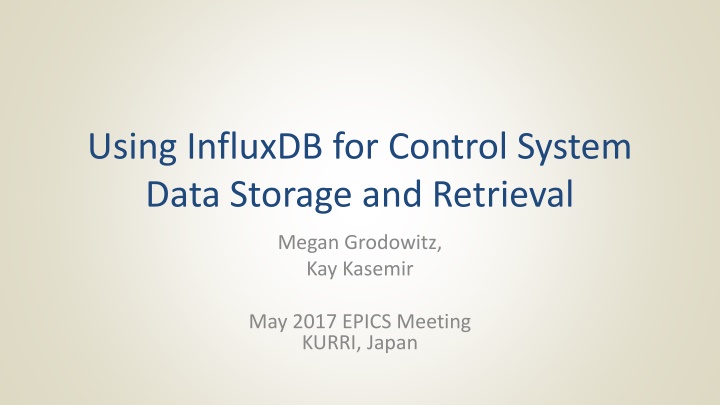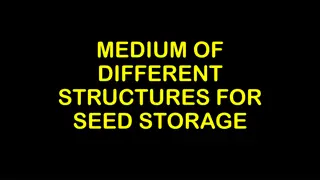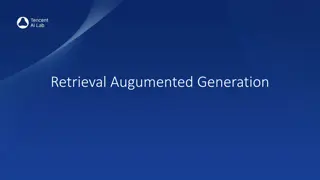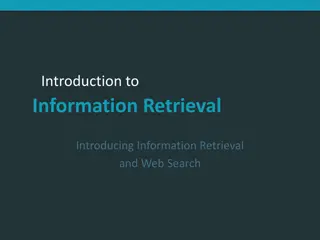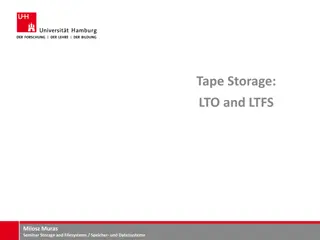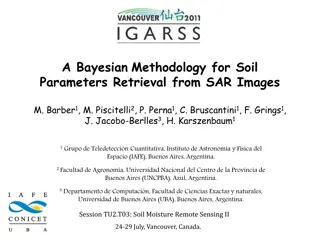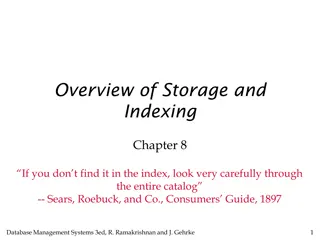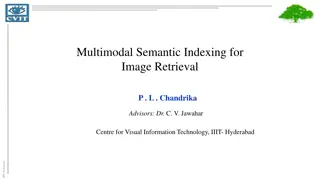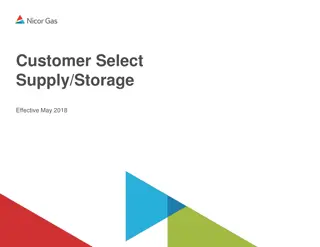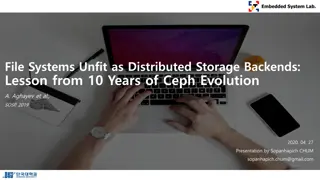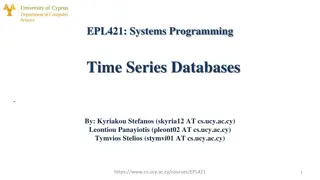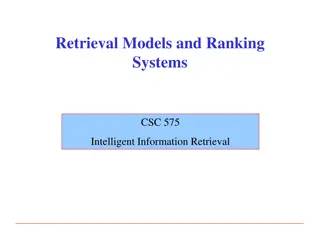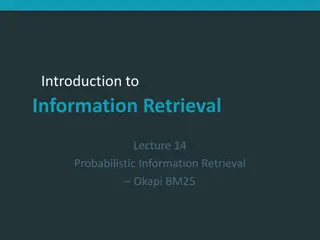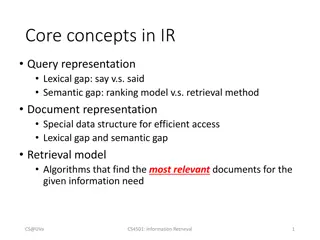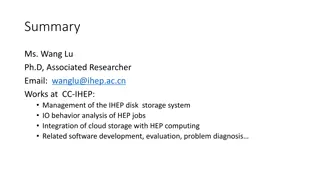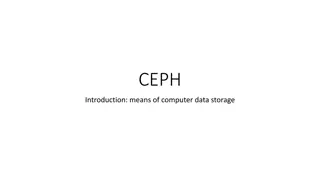Using InfluxDB for Control System Data Storage and Retrieval
"EPICS Channel History Storage Requirements, history of control system data storage at SNS, overview of InfluxDB database concepts including measurements, tags, fields, and retention policy for efficient time series data storage and retrieval."
Download Presentation

Please find below an Image/Link to download the presentation.
The content on the website is provided AS IS for your information and personal use only. It may not be sold, licensed, or shared on other websites without obtaining consent from the author.If you encounter any issues during the download, it is possible that the publisher has removed the file from their server.
You are allowed to download the files provided on this website for personal or commercial use, subject to the condition that they are used lawfully. All files are the property of their respective owners.
The content on the website is provided AS IS for your information and personal use only. It may not be sold, licensed, or shared on other websites without obtaining consent from the author.
E N D
Presentation Transcript
Using InfluxDB for Control System Data Storage and Retrieval Megan Grodowitz, Kay Kasemir May 2017 EPICS Meeting KURRI, Japan
EPICS Channel History Storage Requirements (Needs) Reliable, Available, Maintainable Compatible with multiple languages Long term data storage Performant enough Requirements (Wants) Much better performance than current minimal requirement Better user experience from clients reading data Room to add many more channels to archives than we are currently doing Ease of use (installation, querying) External tools availability 1
History of Control System Data Storage at SNS In the beginning: Channel Archiver (2000-2009) Custom solution -> fast C++ access only, unmaintainable file structure Oracle RDB (2009-present) Very reliable Slow Quirks Picked TIMESTAMP w/o TIMEZONE (hard to correct w/ existing data) Inefficient SQL to obtain sample at-or-before start time Purging time ranges requires special consideration in data layout 2
InfluxDB https://www.influxdata.com/ Time series database NoSQL Each sample in a series is identified by a unique timestamp REST API interface with query language Reachable from any language or script that can make HTTP requests Responses in JSON format Designed to be one component in a set of interoperable services Does not try to do everything in one package. Just stores and retrieves time series data as efficiently as possible Use cases: IoT: gather data from sensors and make decisions from data analysis https://spiio.com/ (plant irrigation monitoring and planning) http://www.bboxx.co.uk/ (solar energy devices deployed to remote locales) Datacenter monitoring Replace tools like Nagios/Elasticsearch to keep large numbers of computer systems up and running 3
InfluxDB Database concepts Measurements PV , Channel Sort of like an RDB table, top level structure Example measurement: Temperature Tags How data is indexed and searched, always a string key/value pair Example tag: location=Northwest corridor Fields What data is stored, string key with value of long, double, bool, or string type Example field: degrees=78.8 Retention Policy How long to keep data, and what to do with it as it ages Example retention policy: Create retention policy one_day_by_hour duration 1d shard duration 1h Hold onto this data for one day, make a new shard of data for each hour Series A unique set of measurement + tags + retention policy Contains samples with unique time stamps and arbitrary field data Tags should not have a large number of distinct values Fields are values that are being monitored and take on many different values Retention policies can be used to set up continuous downsampling, since values are searchable by retention policy name The larger the number of series, the more hardware resources are required 4
Custom RDB InfluxDB Reliability, Uptime DIY High High? Speed Fast Slow Fast Access from Java, C, Python, .. DIY Yes Yes Web Access DIY DIY Yes Query Language DIY Yes Yes Data Retention, Decimation DIY DIY partitioning can help Yes Patch existing Samples DIY Yes Yes Insert/Remove older Samples DIY Yes Yes Rename Channel DIY Yes Same as copying samples Store Images, large Waveforms DIY No No Used beyond EPICSArchive No Yes Yes 5
Archive Engine using InfluxDB Archive Engine Archive Engine RDB Config RDB Writer XML Config Influx Writer PV PV XML RDB InfluxDB 6
Sources https://github.com/ghmegan/influxdb-java InfluxDB library for Java https://github.com/ghmegan/archive-influxdb archive.config.xml, archive.writer.influx and .reader.influx https://github.com/ControlSystemStudio/cs-studio CS-Studio branch influxdb-archive-app https://github.com/ControlSystemStudio/org.csstudio.sns Archive Engine Binaries on http://ctrl-ci.sns.gov/snapshot/css-nightly .. about to be merged into main cs-studio repository.. 7
EPICS-Specific Storage in InfluxDB Two databases 1. data : samples with values stored in fields labeled by type and index A typical EPICS PV (double type) uses one field, called double.0 , along with tag values for status, severity, NaN flag An array PV uses fields with names double.0 , double.1 , etc and can change array size dynamically for each sample 2. meta : logs a new entry each time the PV type changes Typical case, the metadata store contains one entry the first time the PV was logged tracks the initial date the PV was added to the archive Suppose a PV changes from a double to string type, just add a new metadata entry when it changes, and the old samples can be maintained without any changes 8
Free/Open source InfluxDB instance for testing 2 databases in use for our test system Metadata timestamp shows this PV was added at 4pm GMT on 4/24 Select earliest five samples stored Select most recent 5 samples stored PV value in double.0 is a field, and takes on many different values. Severity and status are tags, few values, used as indexes. Tags are not stored over and over again for the same value 9
EPICS PV Storage: Speed Tests RDB Setup: PostgreSQL 9 Intel Core Duo 3GHz, Windows 7 250gb 7200 RPM SATA Disk InfluxDB Setup: InfluxDB ver. 1.1 Intel i7 3.6GHz, RHEL 7 500GB 7200 RPM SATA Disk Read Test Setup Read PV values from a given time range, up to a max of 1 million values Includes initial sample, i.e. last sample at-or-before requested start time Reading this initial sample can at times add a large delay to reading from RDB (*) Write Test Setup Write as many samples as possible in 60 seconds RDB InfluxDB Read ~96K samples/sec (*) ~353K samples/sec Write rewriteBatchedStatements=false: ~7K samples/sec rewriteBatchedStatements=true: ~21K samples/sec flushCount=10K (recommended) ~110Ksamples/sec flushCount=200K (less reliable) ~185K samples/sec 10
CSS Databrowser Oracle and influxDB data sources for the same PV over 9 days InfluxDB retrieval plugin does not do server side downsampling yet, so the lower graph includes spikes indicating the std deviation of the data points being averaged on the client side InfluxDB is added as a datasource, with the URL:port for the server 11
Non-EPICS data access in CSS During work on the influxDB plugins, we connected with other people at SNS using influxDB to log non-EPICS data Python scripts doing analysis and dumping samples into various schemas on various systems Using tools like grafana to view data Wanted CS-Studio databrowser functionality for their data Single environment with EPICS and non-EPICS data Can we support both? How? Created a separate plugin for raw access to influxDB through CS-Studio No metadata required, it is all generated with default values User indicates influxdb-raw data source, then notates PVs with influxDB http request protocol: database name, measurement name, tags, field Any data stored in influxDB in any format is now viewable in CS-Studio 12
Data Browser for Generic InfluxDB EPICS schema Data Source influxdb://host.site.org:8086 PV MyRecord Measurement Field Tags (optional) RTBT_Diag:BCM25I:Power10,severity=NONE double.0 Any schema Data Source influxdb-raw://host.site.org:8086?... db=archive_test_data& user=..&password=.. PV measurement,tag=value field Drag search results
Grafana Generic InfluxDB data viewing tool https://grafana.com/ Free on Windows/Mac/Linux This graph took 5 minutes to setup Add data source for our InfluxDB server Set archive_test_data as the database Use the dropdown menu in the panel creator to select from a list of PVs in the database Use the time range selection at the upper right to set the range to graph Click and edit titles, axes, 14
InfluxDB Time-series database Ideal for logging EPICS PVs Faster than RDB Supported by CS-Studio Archive Engine Data Browser Pending tests Archive Engine w/ SNS configs Synthetic data for longer time range based on actual site config files Checking free vs. commercial license support & multi-node installation 15
